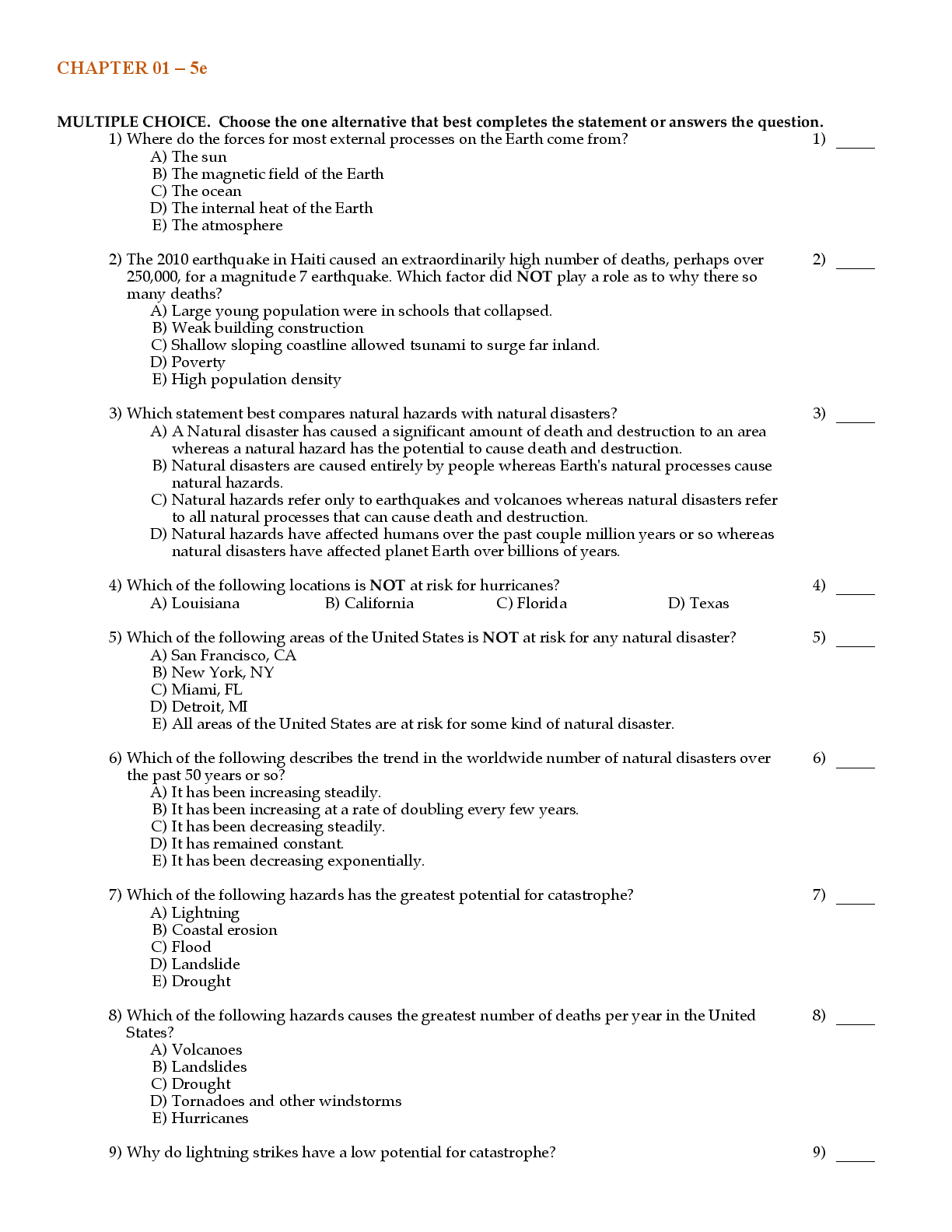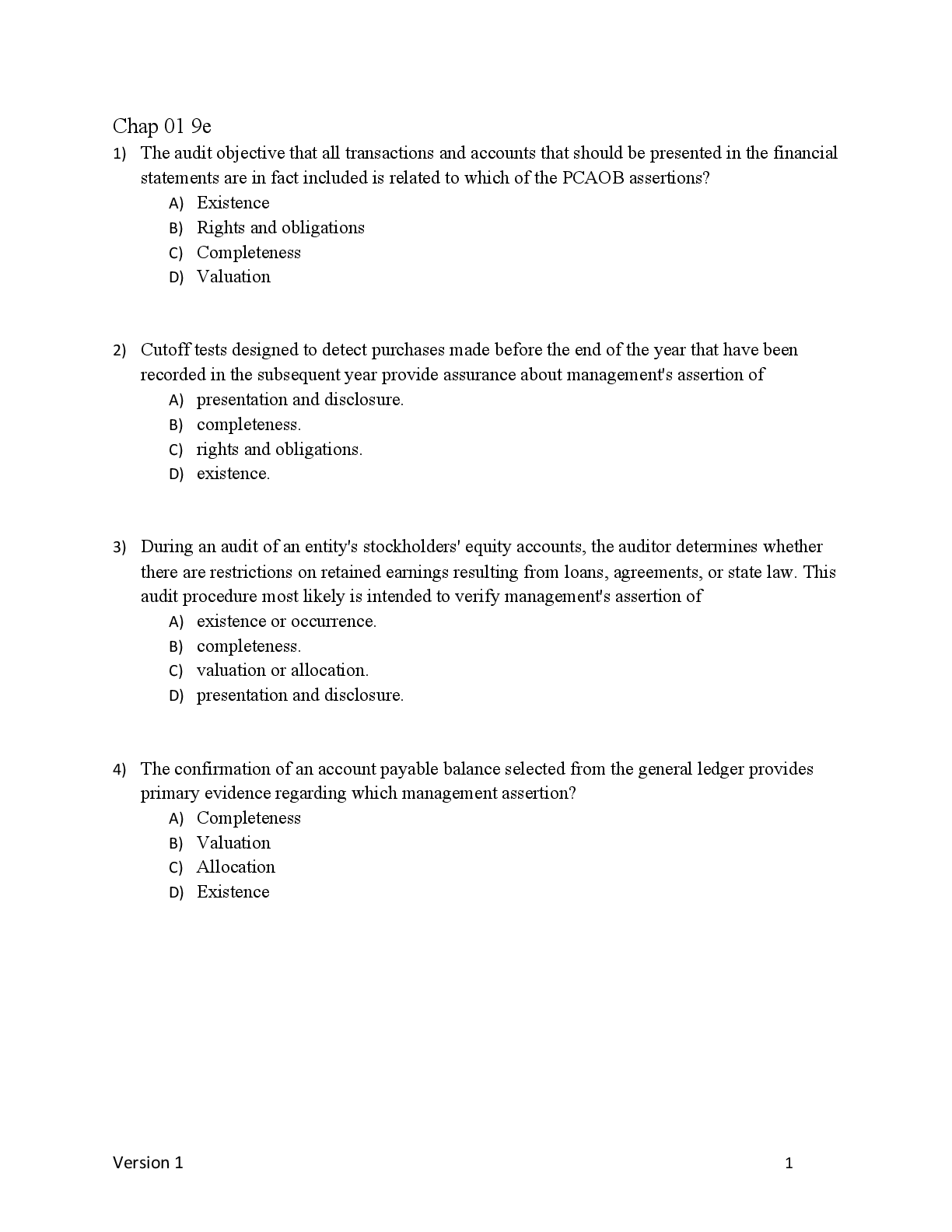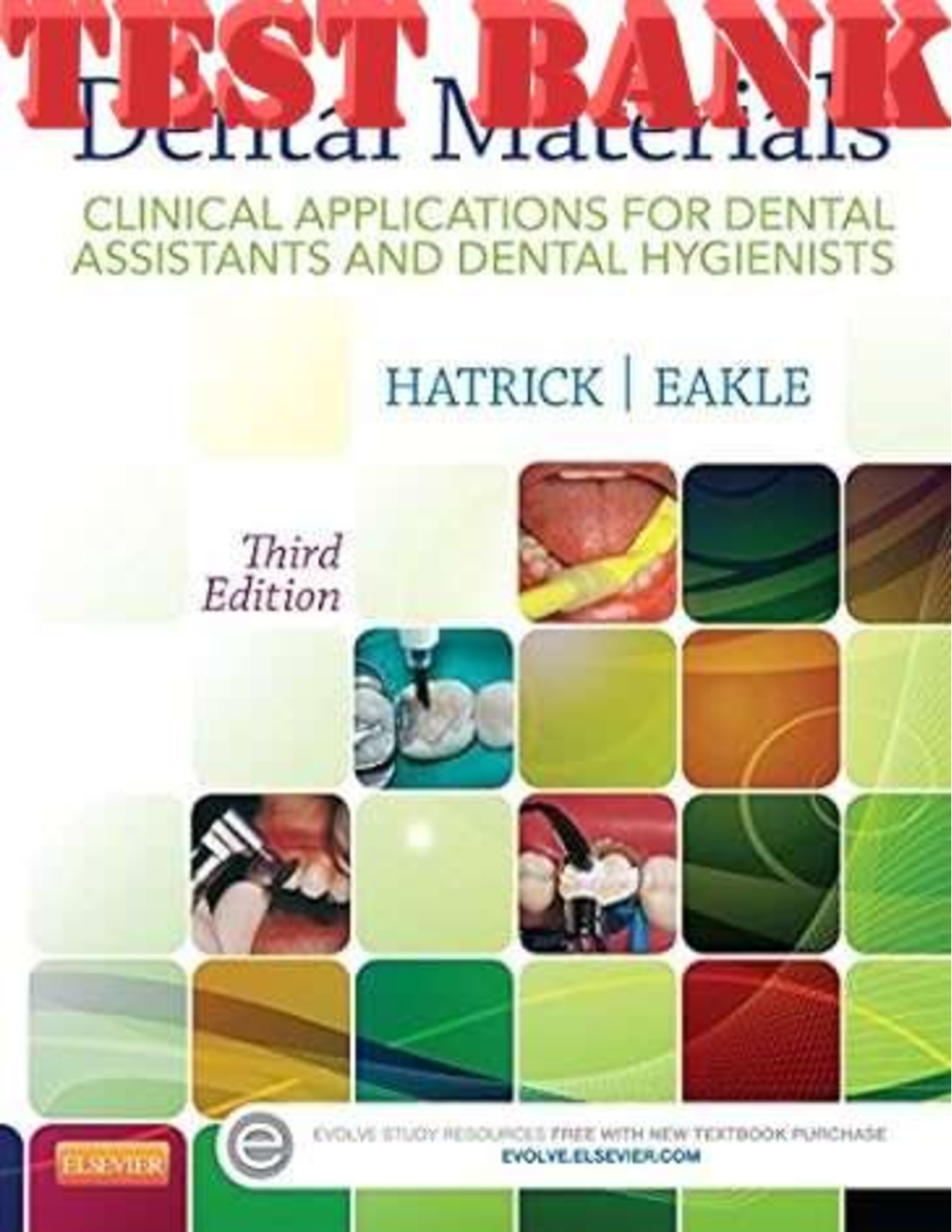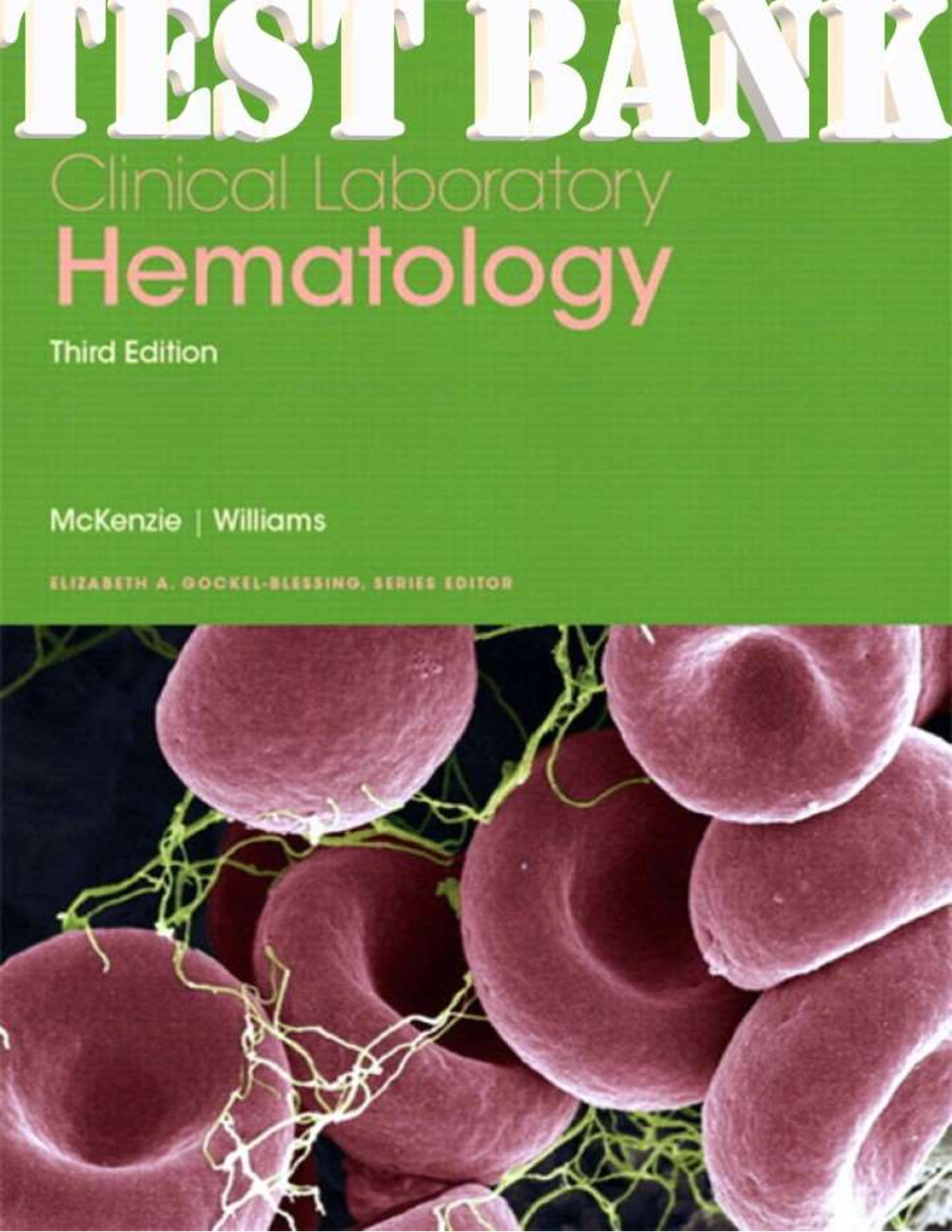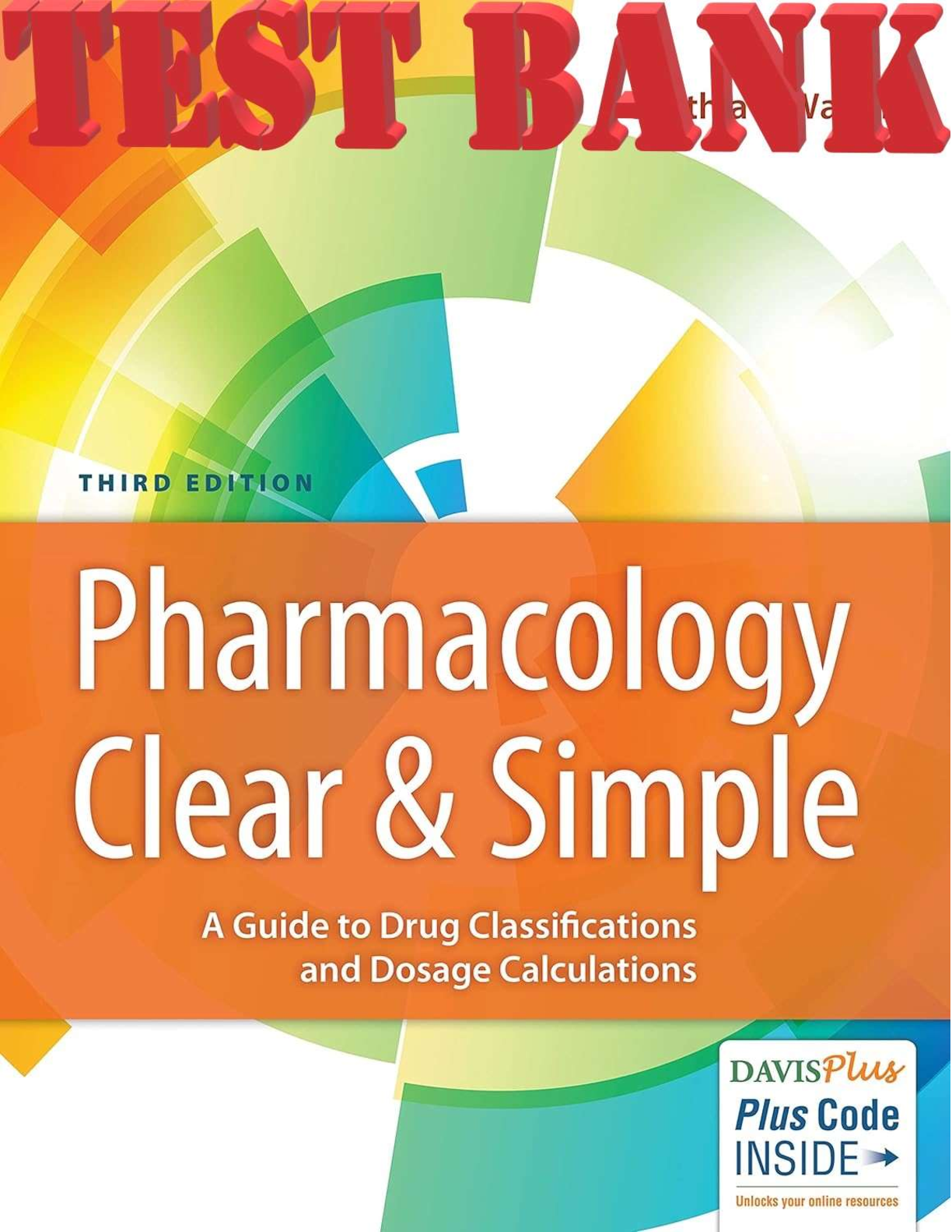Chemistry > TEST BANK > Chemistry: An Atoms First Approach, 3rd Edition by Steven Zumdahl, Susan & Donald DeCoste l TEST BAN (All)
Chemistry: An Atoms First Approach, 3rd Edition by Steven Zumdahl, Susan & Donald DeCoste l TEST BANK
Document Content and Description Below
Test Bank for Chemistry An Atoms First Approach, 3rd Edition,3e by Steven S. Zumdahl, Susan A. Zumdahl TEST BANK ISBN-13: 9780357363614 Full chapters included Chapter 1: Chemical Foundations 1.1... Chemistry: An Atoms-First Approach 1.2 The Scientific Method 1.3 Fundamental Chemical Laws 1.4 Dalton's Atomic Theory 1.5 Early Experiments to Characterize the Atom 1.6 The Modern View of Atomic Structure: An Introduction For Review Chapter 2: Atomic Structure and Periodicity 2.1 Electromagnetic Radiation 2.2 The Nature of Matter 2.3 The Atomic Spectrum of Hydrogen 2.4 The Bohr Model 2.5 The Quantum Mechanical Model of the Atom 2.6 Quantum Numbers 2.7 Orbital Shapes and Energies 2.8 Electron Spin and the Pauli Principle 2.9 Polyelectronic Atoms 2.10 The History of the Periodic Table 2.11 The Aufbau Principle and the Periodic Table 2.12 Periodic Trends in Atomic Properties For Review Chapter 3: Bonding: General Concepts 3.1 Types of Chemical Bonds 3.2 Electronegativity 3.3 Ions: Electron Configurations and Sizes 3.4 Partial Ionic Character of Covalent Bonds 3.5 The Covalent Chemical Bond: A Model 3.6 The Localized Electron Bonding Model 3.7 Lewis Structures 3.8 Exceptions to the Octet Rule 3.9 Resonance 3.10 Naming Simple Compounds For Review Chapter 4: Molecular Structure and Orbitals 4.1 Molecular Structure: The VSEPR Model 4.2 Bond Polarity and Dipole Moments 4.3 Hybridization and the Localized Electron Model 4.4 The Molecular Orbital Model 4.5 Bonding in Homonuclear Diatomic Molecules 4.6 Bonding in Heteronuclear Diatomic Molecules 4.7 Combining the Localized Electron and Molecular Orbital Models For Review Chapter 5: Stoichiometry 5.1 Counting by Weighing 5.2 Atomic Masses 5.3 Learning to Solve Problems 5.4 The Mole 5.5 Molar Mass 5.6 Percent Composition of Compounds 5.8 Chemical Equations 5.9 Balancing Chemical Equations 5.10 Stoichiometric Calculations: Amounts of Reactants and Products 5.11 The Concept of Limiting Reactant For Review Chapter 6: Types of Chemical Reactions and Solution Stoichiometry 6.1 Water, the Common Solvent 6.2 The Nature of Aqueous Solutions: Strong and Weak Electrolytes 6.3 The Composition of Solutions 6.4 Types of Chemical Reactions 6.5 Precipitation Reactions 6.6 Describing Reactions in Solution 6.7 Stoichiometry of Precipitation Reactions 6.8 Acid-Base Reactions 6.9 Oxidation-Reduction Reactions 6.10 Balancing Oxidation-Reduction Equations For Review Chapter 7: Chemical Energy 7.1 The Nature of Chemical Energy 7.2 Enthalpy 7.3 Calorimetry 7.4 Hess's Law 7.5 Standard Enthalpies of Formation 7.6 Covalent Bond Energies and Chemical Reactions 7.7 Present Sources of Energy 7.8 New Energy Sources For Review Chapter 8: Gases 8.1 Pressure 8.2 The Gas Laws of Boyle, Charles, and Avogadro 8.3 The Ideal Gas Law 8.4 Gas Stoichiometry 8.5 Dalton's Law of Partial Pressures 8.6 The Kinetic Molecular Theory of Gases 8.7 Effusion and Diffusion 8.8 Real Gases 8.9 Characteristics of Several Real Gases 8.10 Chemistry in the Atmosphere For Review Chapter 9: Liquids and Solids 9.1 Intermolecular Forces 9.2 The Liquid State 9.3 Vapor Pressure and Changes of State 9.4 Phase Diagrams 9.5 An Introduction to Structures and Types of Solids 9.6 Structure and Bonding in Metals 9.7 Carbon and Silicon: Network Atomic Solids 9.8 Molecular Solids For Review Chapter 10: Properties of Solutions 10.1 Solution Composition 10.2 The Energies of Solution Formation 10.3 Factors Affecting Solubility 10.4 The Vapor Pressures of Solutions 10.5 Boiling-Point Elevation and Freezing‑Point Depression 10.6 Osmotic Pressure 10.7 Colligative Properties of Electrolyte Solutions 10.8 Colloids For Review Chapter 11: Chemical Kinetics 11.1 Reaction Rates 11.2 Rate Laws: An Introduction 11.3 Determining the Form of the Rate Law 11.4 The Integrated Rate Law 11.5 Reaction Mechanisms 11.6 A Model for Chemical Kinetics 11.7 Catalysis For Review Chapter 12: Chemical Equilibrium 12.1 The Equilibrium Condition 12.2 The Equilibrium Constant 12.3 Equilibrium Expressions Involving Pressures 12.4 Heterogeneous Equilibria 12.5 Applications of the Equilibrium Constant 12.6 Solving Equilibrium Problems 12.7 Le Chatelier's Principle For Review Chapter 13: Acids and Bases 13.1 The Nature of Acids and Bases 13.2 Acid Strength 13.3 The pH Scale 13.4 Calculating the pH of Strong Acid Solutions 13.5 Calculating the pH of Weak Acid Solutions 13.6 Bases 13.7 Polyprotic Acids 13.8 Acid-Base Properties of Salts 13.9 The Effect of Structure on Acid-Base Properties 13.10 Acid-Base Properties of Oxides 13.11 The Lewis Acid-Base Model 13.12 Strategy for Solving Acid-Base Problems: A Summary For Review Chapter 14: Acid-Base Equilibria 14.1 Solutions of Acids or Bases Containing a Common Ion 14.2 Buffered Solutions 14.3 Buffering Capacity 14.4 Titrations and pH Curves 14.5 Acid-Base Indicators For Review Chapter 15: Solubility and Complex Ion Equilibria 15.1 Solubility Equilibria and the Solubility Product 15.2 Precipitation and Qualitative Analysis 15.3 Equilibria Involving Complex Ions For Review Chapter 16: Spontaneity, Entropy, and Free Energy 16.1 Spontaneous Processes and Entropy 16.2 Entropy and the Second Law of Thermodynamics 16.3 The Effect of Temperature on Spontaneity 16.4 Free Energy 16.5 Entropy Changes in Chemical Reactions 16.6 Free Energy and Chemical Reactions 16.7 The Dependence of Free Energy on Pressure 16.8 Free Energy and Equilibrium 16.9 Free Energy and Work For Review Chapter 17: Electrochemistry 17.1 Balancing Oxidation-Reduction Equations 17.2 Galvanic Cells 17.3 Standard Reduction Potentials 17.4 Cell Potential, Electrical Work, and Free Energy 17.5 Dependence of Cell Potential on Concentration 17.6 Batteries 17.7 Corrosion 17.8 Electrolysis 17.9 Commercial Electrolytic Processes For Review Chapter 18: The Nucleus: A Chemist's View 18.1 Nuclear Stability and Radioactive Decay 18.2 The Kinetics of Radioactive Decay 18.3 Nuclear Transformations 18.4 Detection and Uses of Radioactivity 18.5 Thermodynamic Stability of the Nucleus 18.6 Nuclear Fission and Nuclear Fusion 18.7 Effects of Radiation For Review Chapter 19: The Representative Elements 19.1 A Survey of the Representative Elements 19.2 The Group 1A (1) Elements 19.3 The Chemistry of Hydrogen 19.4 The Group 2A (2) Elements 19.5 The Group 3A (13) Elements 19.6 The Group 4A (14) Elements 19.7 The Group 5A (15) Elements 19.8 The Chemistry of Nitrogen 19.9 The Chemistry of Phosphorus 19.10 The Group 6A (16) Elements 19.11 The Chemistry of Oxygen 19.12 The Chemistry of Sulfur 19.13 The Group 7A (17) Elements 19.14 The Group 8A (18) Elements For Review Chapter 20: Transition Metals and Coordination Chemistry 20.1 The Transition Metals: A Survey 20.2 The First-Row Transition Metals 20.3 Coordination Compounds 20.4 Isomerism 20.5 Bonding in Complex Ions: The Localized Electron Model 20.6 The Crystal Field Model 20.7 The Biological Importance of Coordination Complexes 20.8 Metallurgy and Iron and Steel Production For Review Chapter 21: Organic and Biological Molecules 21.1 Alkanes: Saturated Hydrocarbons 21.2 Alkenes and Alkynes 21.3 Aromatic Hydrocarbons 21.4 Hydrocarbon Derivatives 21.5 Polymers 21.6 Natural Polymers [Show More]
Last updated: 1 month ago
Preview 10 out of 850 pages

Loading document previews ...
Buy this document to get the full access instantly
Instant Download Access after purchase
Buy NowInstant download
We Accept:

Reviews( 0 )
$23.00
Can't find what you want? Try our AI powered Search
Document information
Connected school, study & course
About the document
Uploaded On
Aug 28, 2022
Number of pages
850
Written in
Additional information
This document has been written for:
Uploaded
Aug 28, 2022
Downloads
1
Views
244

